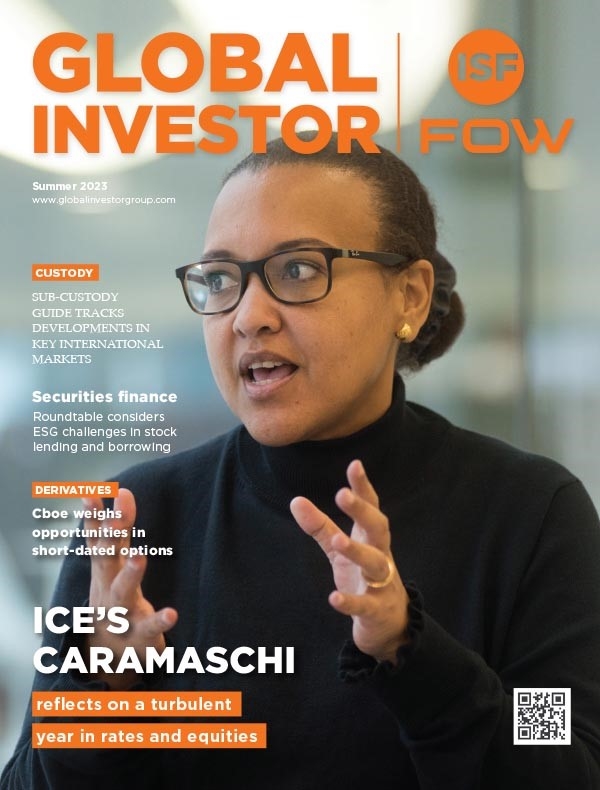BNP Paribas SS: The network effect

How will Target2-Securities (T2S) change things for your
clients?
T2S is a massive structural change to European financial
markets that fundamentally increases stability and efficiency for settlements
in central bank money by harmonising the process in all markets. Firms across
the industry in Europe will automatically benefit from this advance. But T2S
also comes with features, for example enhanced liquidity management, that we as
a local custodian can help clients access and make the most of.
Before T2S, when an Italian client, for example, wanted to
deposit a German bond in exchange for a cash payment, the process was supported
by a connection between two central securities depositories (CSDs).
This meant that delivery was not typically versus-payment –
it was free-of-payment with the cash settlement coming separately. Using a
single external settlement engine for cross-border settlement in T2S means that
all transactions will be delivery-versus-payment and the process of exchange
will become much more efficient.
What are the implications for domestic asset servicing?
The T2S platform, which supports settlement, is operated by
the ECB but asset servicing at the local level remains entirely in the domain
of domestic custodians. This means that custodians such as BNP Paribas play an
essential role operating accounts within local infrastructures to deliver asset
servicing, tax and corporate actions support to clients.
Early in the evolution of T2S there was concern that the
efficiency of these functions would be threatened by the need to migrate onto
an alternate system and the result would be increased costs. In response, the
large CSDs have worked to ensure the process of decommissioning legacy systems
and replacing them has not meant increased costs for end-users.
What are the implications of T2S-compliant solutions for
liquidity?
The new T2S solutions enable a whole range of liquidity
management options. T2S includes features such as auto-collateralisation that
helps participants access liquidity in central bank money based on the assets
that they are buying. For example, to finance the purchase of a fixed income
instrument, T2S creates an intraday repo with the central bank generating the
cash required for settlement, with the bond acting as the collateral. This
process is supported not only in the client’s domestic market but also for
trades that cross European borders.
Consider the case of an Italian client with a large
portfolio of French securities that is purchasing Italian bonds. Assuming the
client has signalled to us that it would like to take advantage of this
feature, the system can select the collateral required either from the French
portfolio or from the Italian bond purchase.
The benefits of this become apparent when you consider that,
for certain transactions or at certain CSDs, the Italian bonds may attract a
punitive haircut with the need to collateralise other assets to fulfil the
settlement obligation.
Does it increase the number of netting opportunities?
Yes, better netting is another benefit. Because everything settles through T2S, the diverse spread of CSDs can all be viewed as a single netting resource.
Clients
can benefit from positions across all European CSDs, which are supported by the
same custodian, being shared from a netting point of view. And because a sale
in the French market, for example, could be netted off with a purchase in the
Spanish market, the client needs ultimately to make less liquidity available to
settle trades in the cash account.
Banks or brokers that are direct participants must not only
finance their own connectivity to multiple infrastructures but can also draw
only on the liquidity in their portfolio. By using a custodian, the firm in
question will have the option to have trades netted off with the shared
liquidity pool that sits in the custodian’s omnibus account.
The larger the custodian and the bigger the asset pool comprised in the omnibus account, the greater the netting benefits.
The more clients a custodian has, and the more diverse the clients are, from the buy and sell side, the more likely it is to have two clients that are trading in opposite directions on a given position, allowing netting benefits by offsetting trades that are passing in different directions. By getting access to the liquidity that this larger asset pool provides, clients end up saving money.
Hence
through custodian intermediation, liquidity requirements are considerably
lower, resulting in little or no costs for the client. This is a big benefit
for clients that want to know how they can best manage the liquidity
requirements for their cash account.
Are there any other benefits?
Another benefit of new
T2S-enabled settlement process is that it provides more functionality related
to settlement. Onesuch benefit is “hold and release”, where clients can specify
when a given trade should settle. Ensuring that the client has the stock in
question before we release it into the system, for example, provides additional
credit or securities protection. The transaction linkage facility in T2S is
also a great add-on.
Where two transactions occur at similar times, the new process can ensure simultaneous delivery and receipt, removing the market risk that is created by the client being out of a position for the time that it takes a security to be delivered.
Where do you foresee geographic growth for
your local custody operation?
For custodians, growing a footprint in emerging markets means a more diversified revenue stream, which makes for a more robust business. But more importantly it is about supporting clients. European clients, in particular, have been looking to diversify their investment exposure by increasing allocations to emerging markets.
The increase in
regulation in recent years, and the greater emphasis on asset safety, has meant
that the ability to provide local custody services in emerging markets as well
as global custody is very valuable. Because sub-custody is in our DNA we have
had a lot of support from our management to expand this part of our offering.
Under the AIFM directive and Ucits rules, the emphasis on
global custodians’ ability to guarantee the local custody network has
increased. Having a domestic presence in all key markets means that we hold an
average of 90% of client assets within our own network. We can maintain the
full level of segregation of assets from the global all the way through to
local, safekeeping in every case.
A second benefit of a local custody presence is the
synchronisation of global and local processes. In cases where we act locally
the local custody operation runs on the same framework as the global custody
operation, which has benefits for both local and global custody clients. This
has been a considerable operational challenge but brings three major benefits
for clients.
The first is access to local knowledge. This operational
model means that a client can speak to their unique account manager at the
global custody level, who covers the 100-odd markets we serve with a bird’s eye
view. And when they need local colour on a specific position they have a local
manager on the ground there who can answer questions, for example, in Columbia
about a specific corporate event.
When we set up a local branch we bring product and sales
staff who can work closely with domestic clients. So in Hong Kong where were we
have deployed our core local settlement and custody facility, for example, we
have been able to very quickly implement value-added features to support
execution and clearing for the Shanghai-Hong Kong Stock Connect initiative. We
are one of the first global custodians to support an integrated model such as
this.
The second is harmonisation across the sub-custody network
for all corporate actions. This means harmonising the messages, including filed
options, supported by a translation mechanism so that the global system can
absorb all messages coming from the local network before broadcasting them out
to global custody clients.
The third – which is very important – is the ability to roll
out a single tax system, where tax can be managed the same regardless of
whether the service is global or local custody and there is ready access for
the client to all local tax documents. This is where much of our investment has
focused – harnessing the processes by which local markets will communicate a
specific tax rule, translating this and hosting it to the online platform.
Two results flow from all this. Firstly, clients end up with
more accurate and timely information, fully leveraging our domestic presence.
Secondly, they are able to control their local account structure through the
global system. This means the client can opt for a flexible account structure and
support model, either local or global or a combination, while benefiting from
the same service standards.
Which developed markets are you focusing on?
We have seen a lot of growth recently in our offering of
local custody in the US. Our experience has been that, while this is a
developed market, many of the clients are keen to see a newcomer. Our fresh
approach and new systems are being welcomed.
For European clients working in the US, meanwhile, our
Lisbon operating centre means that they get servicing on the US market in a
European time zone. So we get this reverse effect from the European franchise
that delivers new clients and additional assets through the functionality we
are offering in the US.
This principle of reciprocal client benefits also applies to emerging markets. Clients that have used us for local custody in Europe will be familiar with our functionality, expertise and service levels. This makes them confident that they can expect the same level of service in the various emerging markets that they are adding to their funds, in search of returns and value for investors. One example is Colombia, which we were among the first custodians to enter.
A second is Turkey, where we can offer clients the benefit
of a specific account structure – which enables them to employ a wider range of
assets on their books as collateral – while complying with the local regulatory
requirement that all assets be segregated.
Found this useful?
Take a complimentary trial of the FOW Marketing Intelligence Platform – the comprehensive source of news and analysis across the buy- and sell- side.
Gain access to:
- A single source of in-depth news, insight and analysis across Asset Management, Securities Finance, Custody, Fund Services and Derivatives
- Our interactive database, optimized to enable you to summarise data and build graphs outlining market activity
- Exclusive whitepapers, supplements and industry analysis curated and published by Futures & Options World
- Breaking news, daily and weekly alerts on the markets most relevant to you



